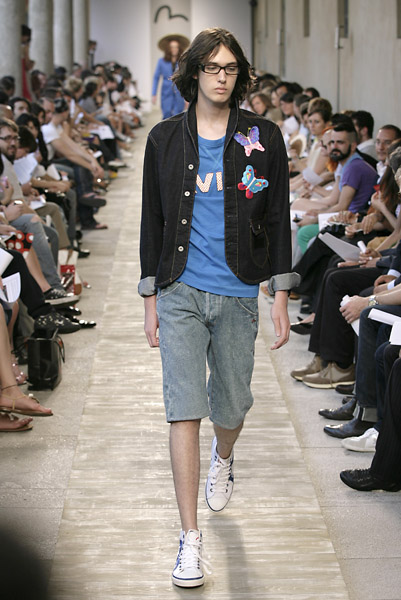s.Oliver is a German lifestyle company which manufactures fashion apparel, accessories, and lifestyle products for men, women, boys, girls, and children. With over $1.2 billion Euro in sales and presence in over 25 countries in Asia , Western and Eastern Europe, the company has some of the coolest collection of denim in Europe . I thought that it might be good idea to speak to Florian Schneider - the head of Product Development Denim at s.Oliver Asia – and find out what makes the company so cool and to learn from him about the latest in denim developments .
Hi Florian. Tell us something about s.Oliver ..
s.Oliver is one of the most successful fashion and lifestyle companies in Europe, and was founded by Bernd Freier in Würzburg, Germany, in 1969. The company’s head office is still in Rottendorf in Franconia today. s.Oliver now employs over 7000 people worldwide, and is represented by 240 of its own stores, 300 franchise stores, 2559 shop-in-shops, and on 3281 areas all over the world.
b) Which are your best denim products?
Our best selling product over the years is a 5-pocket NOS jean for our Casual Women segment. Great fit, classic denim and subtle but perfected vintage wash. Even though we have fantastic products with stunning washes, which range from traditional authentic –e.g. railroad worker inspired jeans – to modern interpretations such as leather-like coatings and washes with a new richness of color, I think it is commercial products with well balanced wash where we are at our absolute best.
b) How do you think is the demand for denim in Europe currently?
Germany is our main market and its economy is recovering at a surprisingly good rate, so does private consumption. The trend towards Chinos and garment-dyed 5-pockets for sure has hurt denim demand a bit, but the impact for us is rather small.
However, the signals I am getting from mills show a trend to an overall slowdown in Europe.
c) Do you think the consumption is on the rise even with the economy being not so good?
In my opinion, consumption in Europe or the US will stay flat for the next couple of years and then eventually pick up speed. In general, rising consumption in developing countries should make up for slow sales elsewhere. This is quite interesting, as the cause for the rising consumption, which is increased salaries and higher living standard, is also the cause why factories struggle to find workers, and brands have difficulties to source for the low prices they are used too.
d) What do you think are the latest trends in denim?
Besides the usual periodical changes in leg shape, clean look vs. vintage wash, and a few longer lasting trends like jeggings, there are two major developments: diversification of garment styles and diversification of denim fabrics.
Denim is expanding far into foreign territory with products such as jeggings, denim down jackets, fully lined denim blazers, knit denim sweat pants, fluid lyocell dresses, and denim chinos. Material variety is leading the pace and getting more diverse to the extent that the line between denim and other products is blurring. Can knit denim be considered denim? What about indigo yarn dyed chambray, indigo over-dyed linen herringbone, jacquard woven denim, indigo corduroy?
Overall there is a lot of excitement and I think we are just at the beginning of a big development.
Now, to give you a more traditional answer, I’d say that 70’s styling is catching on, vintage effects will be overall reduced and denim with wool content or heather weft will be an important novelty. Metallic and leather like coatings have a come-back. Slim fits for men are getting more important, so does cotton/elastane denim for men, and high stretch denims with novelty yarns.
e) Comfort is becoming an increasingly important word in denim which has enabled trends like jegging to be very strong. We have also seen brands like Diesel launching special comfort wear jeans like “Jogg Jeans”. Do you think this is a long term trend?
Europe has been slower than the US in embracing the soft & comfortable trend. However, the super-trend “jeggings” and the success of smaller brands like Current/Elliott that had super soft denim in their collections changed that.
In addition to that, since nowadays denim products include much more than traditional work wear or work wear inspired fashion and can come in the form of any type of garment, hand feel and comfort requirements vary a lot, and tend to go to the soft side.
The trend is here to stay, once the consumer is used to comfort, he or she will not like to go back to less comfortable products. An exemption to that are of course people who have a soft (no pun intended) spot for traditional denim and for that reason of course prefer stiff raw denim jeans.
f)What kind of washes and treatments on denim do you think are popular ? Which is your personal favourite ?
Vintage washing has come a long way, and s.Oliver is very successful with authentic washes. 3D whiskers are a must on most of our washes. Subtle color spray or rubbed-on color is important to add additional depth to the fabric surface and increase richness of color. Dark finishes are getting more popular as are grayish tones.
My favorite wash is a vintage wash that is hand sanded – not sandblasted, washed down with water, enzymes and stones only – without the use of bleach, is not resin treated, and has broken edges not from grinding but from natural formation during washing.
g) China is getting expensive. Do you see shifting of denim production capacities from China to other countries due to this?
The main production area for denim in China is Guangdong Province in the South. Costs are rising in Southern China and labor is increasingly hard to find, so there is indeed a trend to source from other countries like Vietnam or Bangladesh – but also from other provinces in China. Some provinces especially in the North and West still have favorable regulations and low labor cost.
Recently, high cotton prices put even more pressure on brands to compensate rising material costs by lower cm and washing costs.
It is important, though, to keep in mind that other countries have limited work force supply as well, and living standards are on the rise in most developing countries. Considering that the pool of workers in these countries is far smaller than in China, the work force supply can run dry very fast and salaries go up quickly as a result. Therefore it remains to be seen how much of production capacity can be shifted away from China.
h) What do you think about India as a denim sourcing hub?
India has a large cotton production, very good mills and plays a center role for denim fabric sourcing. It is close to production places like Bangladesh and Pakistan.
Since rules have changed and Bangladesh can enjoy the GSP+ benefit even if material origin is in a third country, Indian mills should be able to benefit. In terms of jeans garment manufacturing, I am not sure how big a role India is playing for the European market at this moment, but there is definitely a potential.
i) On a personal note, how many jeans do you have in your wardrobe? How many times do you wear them before you wash them??
I own around 25 pairs, mostly collector’s items and s.Oliver jeans, but currently I wear only two – a Filippa K raw selvedge jeans which I have not washed yet but plan to wash after 8-10 months of wear, and my favorite s.Oliver vintage jeans, which I usually wash after three to four times wearing.
k) Thanks for being on Denimsandjeans.com Any guidance for our readers who are great denim enthusiasts?
Always go for quality instead of quantity!
About Florian : 




